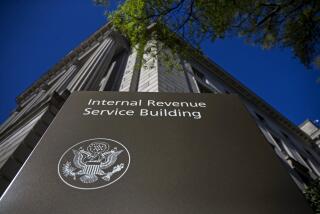Problems With the U.S. Tax Code
- Share via
Ralph Vartabedian’s examination of the U.S. Tax Code (Jan. 5) maps out some of the superficial nooks and crannies of this policy labyrinth but chiefly in only two dimensions: as a source of revenue and as a tool to change society. To really understand the contours of the debate I would suggest adding the topography of campaign finance.
The tortured landscape of this policy monstrosity only makes sense if one checks for where the fast-flowing streams of campaign donations to politicians carve out new canyons of obligation while leaving promontories of privilege untouched against this fiscal El Nino. The real reason we don’t have a flatter tax landscape is that it would lack those fiscal features that attract the rain of dollars from donors wishing to divert tax obligation streams from their homesteads.
Only when campaign finance reform makes it more difficult for politicians to use the tax code as a campaign donation bulldozer will we see a re-landscaping of the tax code.
LARRY MARTINEZ
Santa Barbara
*
I believe three points are evident: The current code desperately needs simplifying; doing it too radically or too suddenly would be bad policy; and some fairness must be sacrificed to avoid the gross waste of productivity now so evident. A five-step simplification process could be made: The most egregious portions of the code deleted or simplified in the first year, then the worst remaining ones the second year and so on toward a specified goal.
Cynics will maintain that this is impossible, it having been tried unsuccessfully in the past. How- ever, it can be done and should be done. If we the public insist on it, it will be done.
RUSS CONNORS
Pismo Beach
*
The article correctly pointed out that the tax code contains 3,000 pages of incomprehensible text, but doesn’t note that the problem of legal bloat is one of all law, not just the tax code. The Motor Vehicle Code of California has 2,000 pages, including, for example, the detailed requirements for licensing a horseless carriage built before 1923. It is also growing. The deep problem is that there is rarely any incentive for repealing a law, and laws just accrete over time. It cannot go on forever.
Over the years we have increasingly separated the taxpayers from the beneficiaries of those same taxes. Currently 60% of the federal income tax is paid by 10% of the taxpayers, so we voters and our representatives are in effect spending other people’s money. There is therefore little incentive toward prudent management of the nation’s resources. The Founding Fathers understood this point. Some European countries are farther down that road than we, and are in deep trouble.
HAL LEWIS
Santa Barbara


